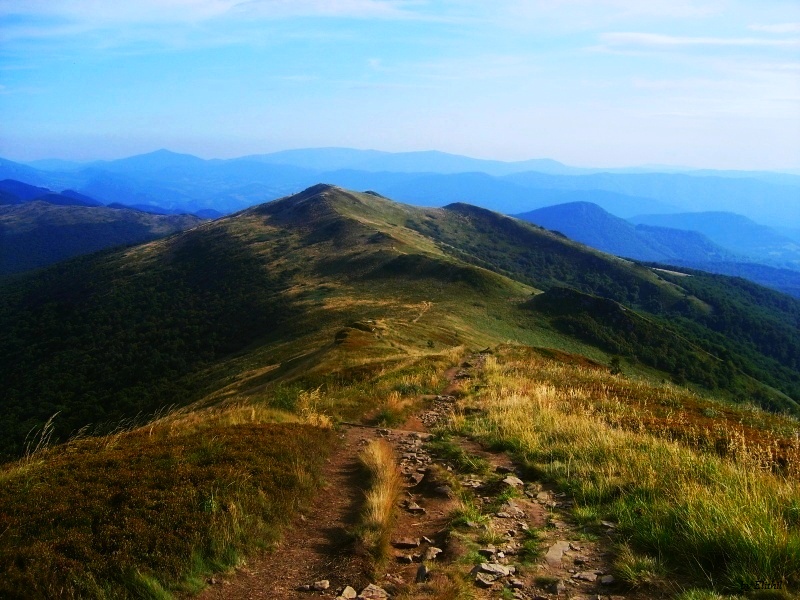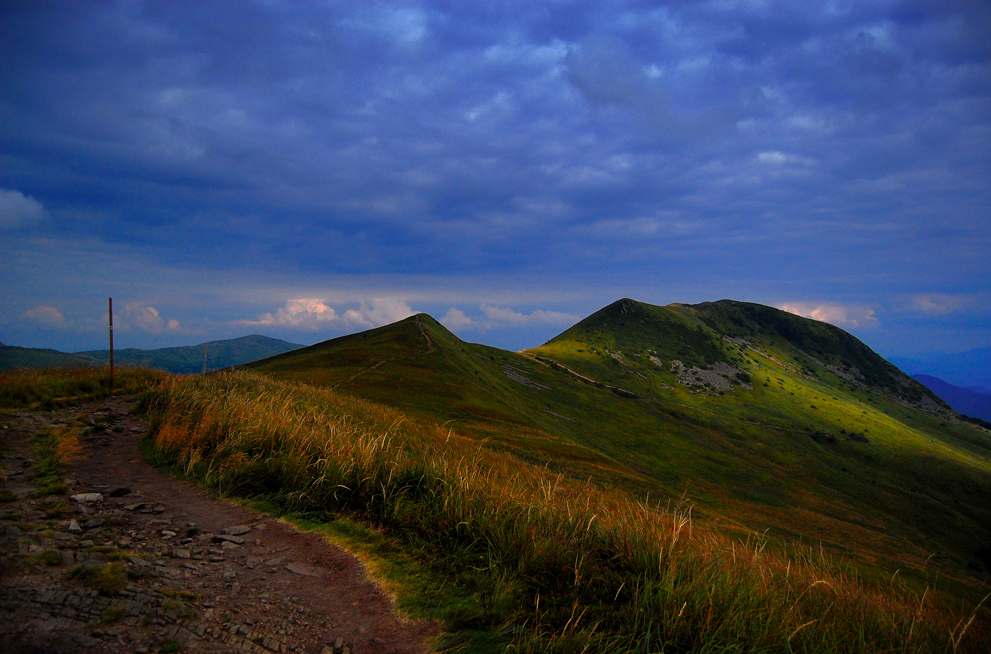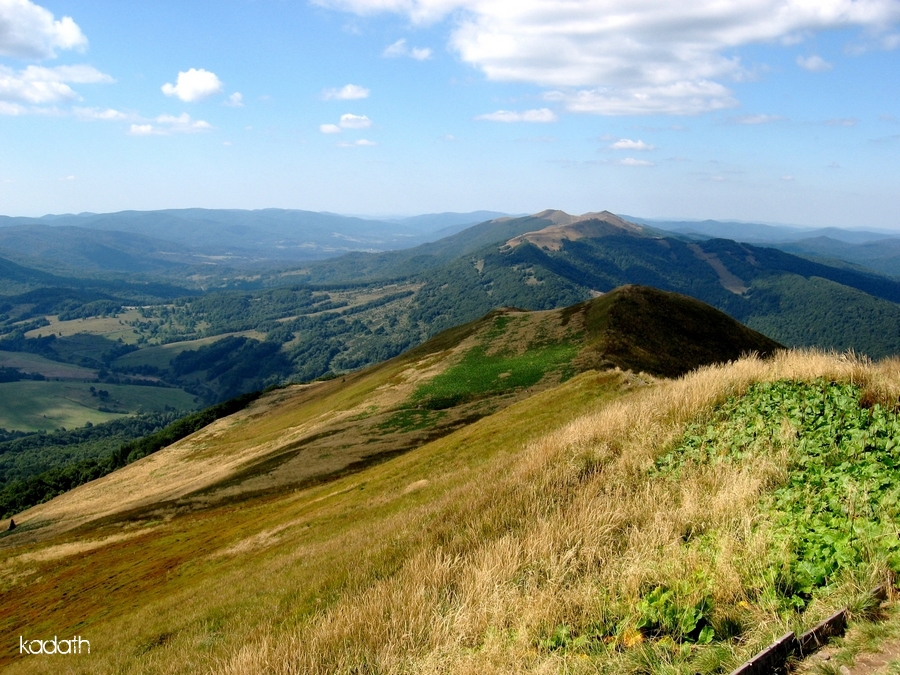Bieszczady Mountains
Dep1dep2
Typical landscape of Bieszczady ( The Krzemień, 1335 m, Poland)
The Bieszczady [b ʲ ɛ'ʃtʃadɨ ] are a low mountain range in south-eastern Poland and adjacent areas in Slovakia and Ukraine. In the strictest sense, they are a part of belonging to Poland and Slovakia Bieszczady ( Bieszczady in Poland and Bukovské Hills in Slovakia, Ukrainian Бещады ). The Bieszczady are also known as Carpathians. The highest point is (depending on the definition of the eastern boundary ) to the summit Tarnica ( Tarnitza ) 1346 m above sea level. M. in Poland.
Etymology
The word Beskid / Beskid is mnd with the word. beshêt, beskēt " vagina watershed " related. Not likely at the origin is from the Wallachian word bjeshkë
History
1269 the landscape is mentioned as Beschad Alpes Poloniae. The landscape was designated in the 15th and 16th centuries as Beyszkod, Byesczad, Byeskad, Byesczad and in the 17th century as Poloniae Alpe Biesczade. The Bieszczady and Beskid terms were historically used for centuries to describe the mountains that separate the poles of Ruthenia and the Kingdom of Hungary.
Nature Equipment
Geology
The near-surface geological subsoil is predominantly formed of tertiary sandstones and flysch.
National park
The Bieszczady National Park is part of the UNESCO Biosphere Reserve established in 1992 Eastern Carpathians ( Carpathian Biosphere Reserve ). The National Park with an area of over 29,000 hectares of the largest Polish Mountain National Park.
Climate
The mean annual temperatures range from 6 ° C in the San valley up to 2 ° C in the peak positions. The average annual precipitation ranges from 900 mm at Lutowiska up to 1200 mm on the ridges. The climate is characterized by Atlantic low foothills that provide much in the winter for snow and in the summer for intensity rainfall. The valleys are often filled with fog that can reach into the high altitudes up.
Vegetation
In the valleys consist floodplain meadows and Bachauenwälder formed esp. of gray alder. On the slopes of beech and silver fir - beech forests are developed, which can make as coppice forest border in about 1100 to 1200 m altitude. It is often but formed by mountain pine and green alder. The subalpine zone is characterized by species-rich Nardus grasslands and rocky corridors. There you will also find the locations of endemic plant species of the Carpathian such as White cow-wheat ( Melampyrum saxosum ) Dichtblütige carnation (Dianthus compactus ), East Carpathian monkshood ( Aconitum lasiocarpum ), pink black salsify ( Scorzonera rosea), Waldstein thistle ( Cirsium waldsteinii ) and Viola Dacica. In a large area, the beech forests have long been no longer used and therefore have jungle-like structures and high percentages of old and dead wood on.
Polo Ninen
A special feature of the Bieszczady are the Polo Ninen. This refers to the non-forested ridges of the hills, which are covered mostly with grasses. Some Polo Ninen previously used as high pasture.
Best-known "Polo Nina ":
In Bieszczady (Poland):
- Połonina Caryńska ( summit 1297 m; portion of the Bieszczady )
- Połonina Wetlińska ( highest elevation: " raw " 1255 m; portion of the Bieszczady )
- Połonina Bukowska ( highest elevation: " Halicz " 1333 m; portion of the Bieszczady )
- Połonina Dźwiniacz ( highest elevation: " Bukowe Berdo " book top 1312 m, part of Bieszczady )
Wildlife
The wild animals of the Bieszczady accommodates all large animal species in Central Europe, such as the brown bear, wolf, lynx, wild cat, bison, deer, beavers and otters in viable populations. Among the bird species are especially golden eagle, eagle and black stork mentioned. Also noteworthy is the Carpathian newt ( Triturus montandoni ), which can be found in all ponds. The bison was reintroduced in the 1920s and has lived in the Bieszczady mountains since 1952 wild. Are the Bieszczady Mountains is one of the most important sanctuaries in Poland for the brown bear. Its population is there given as 50 animals. The large mammals are generally very shy and rarely get to see. At most tracks are to be found more often or the howling of wolves is heard.
Main rivers and streams
In Bieszczady:
- San
- Wisłok ( Weisslog )
- Oslawa ( Oslawa )
- Halicz
- Solinka
- Osławica
- Wetlinka
- Czarny
- Jasieńka
- Królówka
- Dołżyca
- Strwiąż
- Mszanka
In the Bieszczady (Ukraine )
- Usch
- Stry
- Dniester
Tourism
In contrast to the Tatra Mountains Bieszczady are not strongly influenced by tourism. The sooner numerous population of the Bieszczady in 1947 forcibly resettled in the so-called Action Vistula to a great extent. After that, the region remained many years left to themselves. Even today, the human action in nature is low in spite of tourism. The reserve of the Bieszczady National Park is covered with 80% forest, contains one of the least disturbed ecosystems and offers the most important refuge for large animals primeval habitats in Europe. It is therefore also known as the Polish Wild East. Furthermore, the area retains elements of cultural heritage of the for the most part sold Lemken and Boyko such as wooden sacral architecture and traditional agriculture.
Larger towns
- Lesko
- Ustrzyki Górne
- Ustrzyki Dolne
- Solina
- Baligród
- Cisna
- Polańczyk
- Wetlina
- Smerek
- Lutowiska
- Czarna
List of the most important surveys
- Tarnica 1346m
- Krzemień 1335 m
- Halicz 1333 m
- Bukowe Berdo 1312 m
- Wielka Rawka 1307 m
- Polonina Crynska 1297 m
- Raw 1255 m
- Smerek 1222 m
- Krzemieniec 1221 m
- Wołosań 1071 m
- Przysłup 1006 m
- Chryszczata 998 m
- Jaworne 992 m
- Matragona 990 m
- Krąglica 943 m
- Kopa 943 m
- Wysoki Gron 905 m
- Głęboki Wierch 890 m
- Maguryczne 884 m
- Rydoszowa 880 m
- Gmyszów Wierch 876 m
- Pasika 848 m










